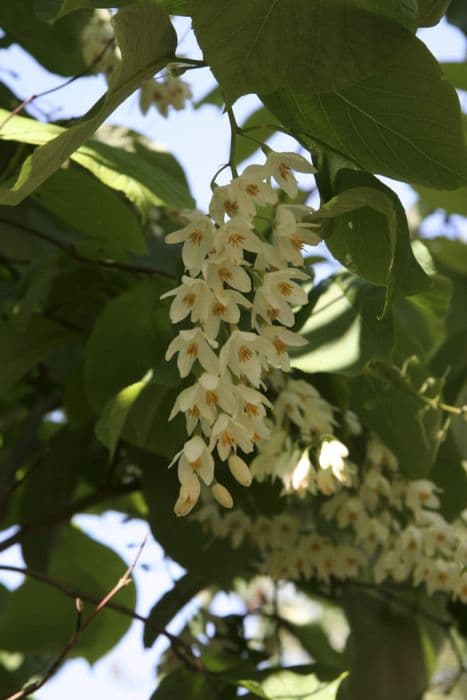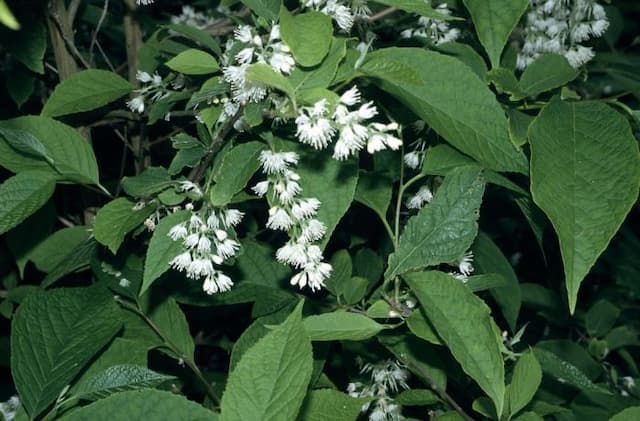Two-wing silverbell Halesia diptera Magniflora Group

ABOUT
Halesia diptera Magniflora Group, commonly known as the Two-winged Silverbell, is noted for its elegant appearance in the landscape. This plant has a branching structure that often divides low to the ground, giving it a layered and slightly spreading look. During its blooming season, it produces an abundance of bell-shaped, white flowers that hang delicately from the branches. These flowers are quite showy and somewhat larger than the ones you might find on other related plants. The petals are smooth and slightly fused at the base, drawing attention with their soft, almost porcelain-like texture. Blooms are generally arranged in pairs, which is a charming characteristic that contributes to the common name of "Two-winged." The leaves of the Two-winged Silverbell are bright green, simple, and ovate to elliptical in shape, with a tendency to turn to golden-yellow in the fall, adding a new layer of visual interest to the plant. After the flowering period, the plant produces distinctive fruit that reflects the "Two-winged" aspect of its name even more. These fruits are dry, brown, and somewhat flattened, with two noticeable wing-like structures that help in wind dispersal. All in all, the Two-winged Silverbell has a gentle and attractive presence thanks to its showy flowers, pleasant leaf shape and color, and unique fruit, which give it ornamental value throughout different seasons.
About this plant
 Names
NamesSynonyms
Two-winged Silverbell, Two-wing Silverbell, Two-winged Snowdrop Tree, Magnificent Silverbell.
Common names
Halesia diptera var. magniflora.
 Toxicity
ToxicityTo humans
The plant commonly known as Two-winged Silverbell is not widely known to be toxic to humans. However, as with any plant, individual allergies or sensitivities could exist. It's always recommended to err on the side of caution and not ingest parts of ornamental plants unless they are known to be edible. If you suspect poisoning from any plant, seek medical attention immediately.
To pets
The plant known as Two-winged Silverbell does not have a well-documented toxicity profile for pets such as dogs and cats. However, it is generally considered non-toxic. Despite this, it is still best to prevent pets from ingesting plants, as individual animals may have unique reactions or sensitivities. If you believe your pet has ingested a potentially poisonous plant, contact your veterinarian or a pet poison control center immediately.
 Characteristics
CharacteristicsLife cycle
Perennials
Foliage type
Deciduous
Color of leaves
Green
Flower color
White
Height
8-12 feet (2.4-3.7 meters)
Spread
10-15 feet (3-4.6 meters)
Plant type
Tree
Hardiness zones
6
Native area
Southeastern United States
Benefits
 General Benefits
General Benefits- Ornamental Appeal: Halesia diptera Magniflora Group, commonly known as Two-wing silverbell, is appreciated for its beautiful, bell-shaped white flowers that offer aesthetic value to gardens and landscapes.
- Wildlife Habitat: Provides food and habitat for various bird species and pollinators, including bees and butterflies.
- Shade Provider: When mature, the Two-wing silverbell's canopy can offer a pleasant shade which can be especially valuable in residential landscaping or public parks.
- Low Maintenance: Once established, it generally requires minimal care, making it a practical choice for gardeners with limited time.
- Drought Resistance: This plant can tolerate periods of low water availability, which is beneficial in arid or drought-prone regions.
- Seasonal Interest: Offers year-round visual interest with its flowers in spring, lush foliage in summer, and sometimes attractive fall color and persistent fruit through winter.
- Adaptability: It is adaptable to a range of soil types, though it prefers moist, well-drained soils, making it versatile for various garden settings.
 Medical Properties
Medical PropertiesThis plant is not used for medical purposes.
 Air-purifying Qualities
Air-purifying QualitiesThis plant is not specifically known for air purifying qualities.
 Other Uses
Other Uses- Stormwater management: Halesia diptera, commonly known as two-winged silverbell, can be planted in rain gardens where it helps in the management of stormwater runoff due to its tolerance for wet conditions.
- Habitat restoration: This species can be used in native plant gardens and habitat restoration projects to help re-establish native ecosystems and support local wildlife.
- Erosion control: With its extensive root system, two-winged silverbell can be effectively used in areas that are prone to soil erosion to help stabilize the ground.
- Shade garden inclusion: As a plant that can thrive in partial shade, it can be incorporated into shade gardens to add vertical interest and spring blossoms.
- Winter garden interest: The distinctive bark and persistent seed pods of Halesia diptera provide visual interest in the garden during the winter months.
- Sound barrier: When planted in groups, two-winged silverbell trees can create a natural sound barrier to reduce traffic noise.
- Edible landscaping: Although not commonly consumed, the seeds of Halesia diptera have been eaten and can be considered for inclusion in edible landscaping designs with proper preparation.
- Photography and painting subject: Its attractive flowers make Halesia diptera a favored subject for botanical photographers and artists.
- Sustainable wood source: Though not widespread, the wood of Halesia diptera can be harvested for crafting small wooden objects or for use in turnery.
- Wildlife shelter: The dense foliage and branches of the tree offer shelter and nesting sites for various bird species.
Interesting Facts
 Feng Shui
Feng ShuiThe Silverbell Tree is not used in Feng Shui practice.
 Zodiac Sign Compitability
Zodiac Sign CompitabilityThe Silverbell Tree is not used in astrology practice.
 Plant Symbolism
Plant Symbolism- Rarity: The Halesia diptera Magniflora Group, commonly known as Two-winged Silverbell or Two-winged Snowdrop Tree, is not as widely known as other ornamental trees, which can symbolize rarity or uniqueness in the plant world.
- Beauty: With its lovely bell-shaped flowers, it represents beauty and grace in the natural landscape.
- Renewal: As a deciduous tree that flowers in spring, the Two-winged Silverbell symbolizes renewal and the start of new beginnings.
- Delicacy: The delicate appearance of its flowers can represent fragility or the need for care and nurturing.
- Peace: The white color of the Silverbell's flowers is often associated with tranquility and peace.
 Water
WaterThe Two-winged silverbell requires regular watering, especially during its growing season in spring and summer. It’s best to water deeply and allow the soil to slightly dry out between waterings. Typically, one should water every week, providing about 1 to 1.5 gallons per watering session for a young tree, adjusting the amount as the tree grows older and larger. During the fall and winter, reduce the watering frequency as the plant's growth slows down. If the tree is planted in well-draining soil, be cautious not to overwater, as this can lead to root rot.
 Light
LightTwo-winged silverbell thrives best in full sun to partial shade. It should be planted in a spot where it can receive at least four to six hours of sunlight a day. Ideally, a location with morning sun and afternoon shade can help protect the tree from the harsh afternoon heat, especially in southern regions.
 Temperature
TemperatureFor the Two-winged silverbell, the ideal temperature range is between 60°F and 80°F. It can tolerate temperatures as low as 20°F, but it's important to protect it from prolonged freezes. The maximum temperature it can withstand is around 90°F, beyond which the plant may experience stress.
 Pruning
PruningTwo-winged silverbell should be pruned to maintain its shape and remove any damaged or diseased branches. The best time for pruning is late winter or early spring before new growth begins. Prune sparingly, as excessive cutting can harm the tree. It is typically required once a year or as needed to maintain a healthy structure.
 Cleaning
CleaningAs needed
 Soil
SoilThe Two-winged Silverbell prefers well-draining soil with a rich organic content, slightly acidic to neutral in pH (5.6-7.5). A mixture of loam, compost, and pine bark or leaf mold would be ideal to ensure proper drainage and fertility.
 Repotting
RepottingTwo-winged Silverbells grown in containers may need repotting every 2-3 years, preferably in the spring before the onset of new growth.
 Humidity & Misting
Humidity & MistingTwo-winged Silverbell thrives in moderate humidity levels, but it is quite adaptable and does not require specific humidity conditions when planted outdoors in its natural habitat.
 Suitable locations
Suitable locationsIndoor
Needs bright indirect light, regular watering, and good airflow.
Outdoor
Plant in partial shade, moist but well-draining soil, mulch recommended.
Hardiness zone
5-9 USDA
 Life cycle
Life cycleHalesia diptera Magniflora Group, commonly known as Two-winged Silverbell or Two-wing Silverbell, begins its life cycle as a seed, which after undergoing stratification (a period of cold to break dormancy), will germinate and grow into a seedling. As the seedling takes root and starts to photosynthesize, it enters the vegetative stage, where it develops its root system and foliage. It then matures into a flowering plant, typically blooming in the spring with pendulous, white bell-shaped flowers that attract various pollinators. Following pollination, it enters the reproductive stage, where flowers develop into characteristic dry, winged fruits which, when mature, disperse seeds into the environment. The plant will then enter a period of dormancy during the colder months, withstanding frost and other harsh conditions. Throughout the years, the silverbell will continue to grow and increase in size, potentially reaching up to 20-30 feet in height, and may live many decades, repeating its annual growth cycle.
 Propogation
PropogationPropogation time
Spring-Early Summer
Propogation: Halesia diptera Magniflora Group, commonly known as Two-winged Silverbell or Two-wing Halesia, is typically propagated by seed. The best time to collect seeds is in the fall when the fruit capsules are dry and brown. Seeds require cold stratification to break dormancy, which involves mixing the seeds with slightly moist sand and storing them at about 40 degrees Fahrenheit (4 degrees Celsius) for 60 to 90 days. After stratification, seeds can be sown in a well-draining soil medium and should germinate when the temperatures warm up in spring. Seedlings can be grown on for one to two years before being planted out in their final location. This natural stratification process closely mimics seasonal cycles, which can enhance germination rates.



![Japanese snowbell [Marley's Pink Parasol]](/_next/image?url=https%3A%2F%2Fplants-admin.emdemapps.com%2Fimages%2Fplants%2F%2Fimages%2F604b602fef992.png&w=640&q=75)
